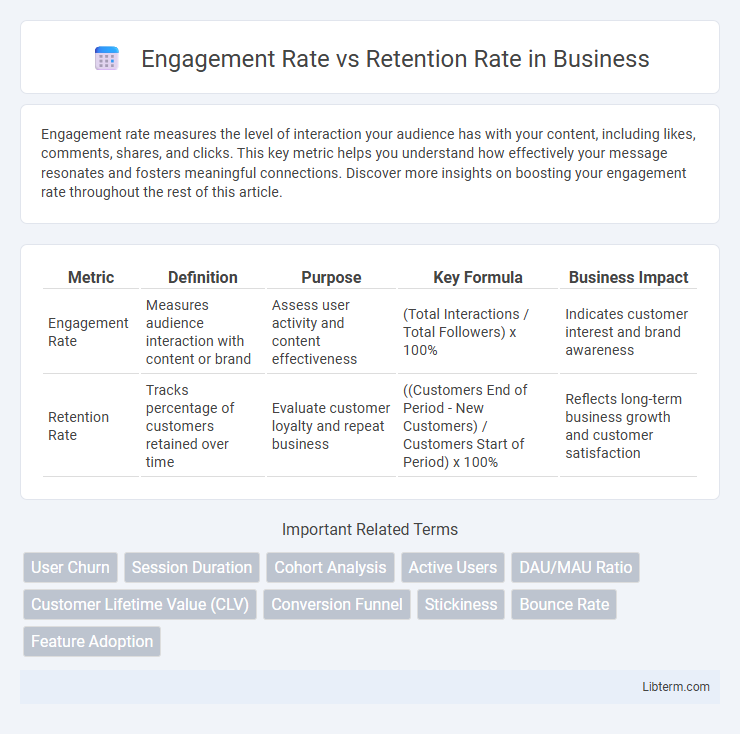Engagement rate measures the level of interaction your audience has with your content, including likes, comments, shares, and clicks. This key metric helps you understand how effectively your message resonates and fosters meaningful connections. Discover more insights on boosting your engagement rate throughout the rest of this article.
Table of Comparison
| Metric | Definition | Purpose | Key Formula | Business Impact |
|---|---|---|---|---|
| Engagement Rate | Measures audience interaction with content or brand | Assess user activity and content effectiveness | (Total Interactions / Total Followers) x 100% | Indicates customer interest and brand awareness |
| Retention Rate | Tracks percentage of customers retained over time | Evaluate customer loyalty and repeat business | ((Customers End of Period - New Customers) / Customers Start of Period) x 100% | Reflects long-term business growth and customer satisfaction |
Introduction to Engagement Rate and Retention Rate
Engagement rate measures how actively users interact with content through likes, comments, shares, and clicks, reflecting immediate audience interest and participation. Retention rate assesses the percentage of users who continue to use a product or service over time, indicating long-term customer loyalty and satisfaction. Both metrics are essential for evaluating digital marketing effectiveness and user experience but focus on different stages of the customer journey.
Defining Engagement Rate
Engagement Rate measures the level of interaction users have with content, typically calculated by dividing total interactions (likes, comments, shares) by the total number of followers or views. This metric highlights how actively audiences participate with a brand's posts or campaigns. Understanding Engagement Rate helps marketers assess content effectiveness and audience interest beyond just reach or impressions.
Defining Retention Rate
Retention rate measures the percentage of users or customers who continue to engage with a product, service, or brand over a specified period. It reflects the ability of a company to maintain its customer base and sustain long-term relationships. High retention rates indicate strong user loyalty and satisfaction, essential for growth and profitability.
Key Differences Between Engagement and Retention
Engagement Rate measures the level of interaction users have with content, such as likes, comments, shares, and clicks, reflecting immediate user involvement. Retention Rate tracks the percentage of users who continue to use a product or service over time, indicating sustained loyalty and long-term satisfaction. Key differences include engagement focusing on short-term user actions while retention emphasizes ongoing user commitment and repeat usage.
Measuring Engagement Rate: Metrics and Methods
Measuring engagement rate involves tracking metrics such as likes, comments, shares, click-through rates, and time spent on content to gauge user interaction and interest. Methods include using social media analytics tools, website tracking software, and survey feedback to collect accurate engagement data. Analyzing these metrics over time helps optimize content strategies and improve audience connection.
Measuring Retention Rate: Metrics and Methods
Measuring retention rate involves tracking the percentage of users who continue to engage with a product or service over a specific period, often calculated by dividing the number of retained users at the end of a time frame by the number of users at the start. Key metrics include cohort analysis, churn rate, and repeat purchase rate, which provide granular insights into customer loyalty and behavior patterns. Methods such as tracking active users through analytics platforms and conducting customer surveys enable businesses to identify retention trends and optimize strategies for sustained engagement.
Importance of Engagement Rate in Business Growth
Engagement rate measures the level of interaction customers have with a brand's content, directly reflecting audience interest and loyalty, which drives sustained revenue growth. High engagement rates indicate strong customer connections, leading to increased word-of-mouth marketing and higher lifetime value. Focusing on engagement rate enables businesses to tailor their strategies for deeper customer relationships, outperforming retention rate metrics alone in predicting long-term success.
Importance of Retention Rate for Customer Loyalty
Retention Rate directly measures the percentage of customers who continue purchasing over time, serving as a critical indicator of customer loyalty and long-term business health. High retention rates lead to increased lifetime value (LTV) and lower customer acquisition costs (CAC), driving sustainable revenue growth. Unlike engagement rate, which tracks interaction frequency, retention rate better reflects satisfied customers and repeat business essential for brand stability.
Strategies to Improve Engagement and Retention
Boosting engagement rate involves creating compelling content tailored to audience interests, leveraging interactive elements like polls or quizzes, and implementing personalized communication through email marketing and social media. Enhancing retention rate requires consistent value delivery, efficient onboarding processes, and timely follow-ups with customers using CRM tools and automated workflows. Data-driven insights from analytics platforms help refine strategies by identifying high-impact touchpoints and optimizing user experience throughout the customer lifecycle.
Choosing Which Metric Matters Most for Your Goals
Engagement rate measures how actively users interact with your content, while retention rate tracks how many users return over time, both critical for assessing audience loyalty. Choosing the right metric depends on your objectives: prioritize engagement rate for campaigns aimed at boosting interaction and brand awareness, or focus on retention rate for long-term customer loyalty and sustained growth. Aligning your strategy with the most relevant metric ensures accurate performance insights and optimized resource allocation.
Engagement Rate Infographic

 libterm.com
libterm.com